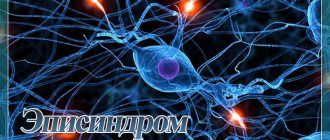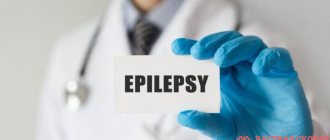Cryptogenic epilepsy is one of the most complex chronic pathologies of the central nervous system, the development of which is due to unknown or uncertain causes. The disease is manifested by regularly recurring specific seizures. The cryptogenic form is found in almost 50% of patients suffering from epileptic seizures.
Cryptogenic epilepsy can be partial, temporal, generalized and focal. With cryptogenic focal epilepsy, patients experience frequent paroxysmal conditions (convulsive seizures). The long course of the disease threatens personality changes, the so-called “epileptic dementia.” This type of pathology is diagnosed mainly at a young age, in patients under 20 years of age, but sometimes occurs in older people. The focal form of cryptogenic epilepsy is practically untreatable, so the patient requires long-term, and most often lifelong, therapy.
What kind of disease is this
Cryptogenic epilepsy has a whole set of epileptic symptoms, the causes of which cannot be determined. The type of illness is hidden. Manifestations of cryptogenic epilepsy are not differentiated from symptoms of other types of disease. With this form, spontaneous electrical impulses occur in the cerebral cortex, causing overexcitation of nerve transmission. As a result, a convulsive focus is formed, provoking an attack.
Seizures can be focal or gradually spreading throughout the victim’s body. The first type of pathology represents limited areas of increased activity in the cerebral cortex.
The symptomatic nature of the disease is detected only with a comprehensive examination of the body. Local abnormalities are detected using magnetic resonance imaging.
Depending on the pathological focus, epilepsy can occur in such lobes as:
- frontal;
- temporal;
- occipital;
- parietal
The frontal form is often accompanied by sudden attacks that last in short series. In rare situations, secondary generalization occurs due to damage to brain cells. If the focus of epileptic activity is localized in the temporal zone, the patient, against the background of regularly manifested emotions, exhibits a phenomenon such as déjà vu. It is this subtype of the disease that is most often encountered in practical medicine. Cryptogenic frontotemporal epilepsy is diagnosed in the same way; the symptoms in this situation are combined.
Pathology is always accompanied by increased activity in the crown area, which is responsible for sensory functions. Victims experience unusual sensory sensations, such as:
- tingling on only one side of the body;
- distorted perception of one's own limbs.
Accompanied by partial seizures, it is the rarest form.
Make an appointment
Reasons for development
To date, it has not been possible to find out why epileptic activity of the cryptogenic type of brain occurs. However, scientists concluded that the development of the disease can be triggered by the following factors:
- burdened heredity;
- complications after traumatic brain injury;
- history of stroke;
- a brain tumor;
- intoxication with chemicals.
The most likely cause of the pathology is considered to be a genetic predisposition.
Cryptogenic epilepsy
This is when the cause is unknown. Now cases of cryptogenic epilepsy are becoming extremely rare, because MRI with a resolution of 1.5 to 3 Tesla can detect minimal changes in brain tissue. Thus, cryptogenic epilepsy “becomes” symptomatic.
Even more common than epilepsy are acute symptomatic epileptic seizures. They occur after abrupt withdrawal of alcohol, during intoxication due to influenza, acute respiratory infections, infectious diseases accompanied by an increase in body temperature, during the acute period of stroke, TBI. These seizures are not epilepsy, but require medical attention.
First signs
The main symptom of epilepsy is seizures. With cryptogenic epilepsy, generalized or partial seizures may occur. Before the onset of partial seizures, more typical of cryptogenic epilepsy, a so-called aura occurs. It signals that a seizure is about to occur. The appearance of the aura allows the doctor to determine the location of the brain lesion.
A motor type aura is accompanied by unexpected movements of the patient, which indicates the location of the affected part in the frontal lobe of the brain. With a rapid deterioration in visual and auditory functions, it can be assumed that the localization of the disorders is in the occipital or temporal lobe.
Expert opinion
Author: Polina Yuryevna Vakhromeeva
Neurologist
In recent years, doctors have noted an increase in the incidence of epilepsy. The exact causes of this disease have not yet been established. It is known that about 4-10 people per 1000 people suffer from seizures. Drug-resistant cryptogenic epilepsy is considered one of the most severe forms of the disease. It is difficult to select treatment for this species due to drug resistance.
A qualified team of doctors at the Yusupov Hospital takes on complex cases. Diagnosis of epilepsy in our clinic is carried out using modern medical equipment. European CT, MRI and EEG equipment are used for examination. They allow you to determine the location of the pathological focus with high accuracy. An analysis of blood and the degree of resistance of the body to drugs is carried out in a modern laboratory.
Therapy for cryptogenic epilepsy is carefully developed by experienced neurologists and epileptologists. In this case, an individual approach is used. Drugs are selected taking into account the degree of drug resistance and other associated conditions. The prescribed medications meet the latest European standards for the treatment of epilepsy.
General principles of treatment of epilepsy
Currently, generally accepted international standards for the treatment of epilepsy have been developed, which must be observed to increase the effectiveness of treatment and improve the quality of life of patients.
Treatment for epilepsy can only begin after an accurate diagnosis has been established. The terms “pre-epilepsy” and “preventive treatment of epilepsy” are absurd. There are two categories of paroxysmal neurological disorders: epileptic and non-epileptic (fainting, sleepwalking, night terrors, etc.), and the prescription of AEDs is justified only in case of illness. According to most neurologists, treatment for epilepsy should begin after a recurrent attack. A single paroxysm can be “random”, caused by fever, overheating, intoxication, metabolic disorders and not related to epilepsy. In this case, the immediate prescription of AEDs cannot be justified, since these drugs are potentially highly toxic and are not used for the purpose of “prevention”. Thus, AEDs can only be used in cases of recurrent, unprovoked epileptic seizures (i.e., epilepsy by definition).
If an accurate diagnosis of epilepsy is established, it is necessary to decide whether AEDs should be prescribed or not? Of course, in the vast majority of cases, AEDs are prescribed immediately after epilepsy is diagnosed. However, with some benign epileptic syndromes of childhood (primarily with rolandic epilepsy) and reflex forms of the disease (reading epilepsy, primary photosensitivity, etc.), it is possible to manage patients without the use of AEDs. Such cases must be strictly reasoned.
The diagnosis of epilepsy was established and it was decided to prescribe AEDs. Since the 1980s, the principle of monotherapy has been firmly established in clinical epileptology: the relief of epileptic seizures should be carried out primarily with one drug. With the advent of chromatographic methods for determining the level of AEDs in the blood, it became obvious that many anticonvulsants have mutual antagonism, and their simultaneous use can significantly weaken the anticonvulsant effect of each. In addition, the use of monotherapy avoids the occurrence of severe side effects and teratogenic effects, the frequency of which increases significantly when multiple drugs are prescribed simultaneously. Thus, the old concept of prescribing a large number of AEDs simultaneously in small doses has now been completely proven to be untenable. Polytherapy is justified only in the case of resistant forms of epilepsy and no more than 3 AEDs at a time.
The selection of AEDs should not be empirical. AEDs are prescribed strictly in accordance with the form of epilepsy and the nature of the attacks. The success of epilepsy treatment is largely determined by the accuracy of syndromic diagnosis (Table 3).
AEDs are prescribed starting with a low dose, with a gradual increase until therapeutic effectiveness is achieved or the first signs of side effects appear. In this case, the determining factor is the clinical effectiveness and tolerability of the drug, and not its content in the blood (Table 4).
If one drug is ineffective, it should be gradually replaced by another AED that is effective for this form of epilepsy. If one AED is ineffective, you cannot immediately add a second drug to it, that is, switch to polytherapy without using all the reserves of monotherapy.
Principles of AED withdrawal.
AEDs can be discontinued after 2.5-4 years of complete absence of attacks. The clinical criterion (absence of seizures) is the main criterion for discontinuation of therapy. In most idiopathic forms of epilepsy, drug withdrawal can be carried out after 2.5 (rolandic epilepsy) - 3 years of remission. In severe resistant forms (Lennox-Gastaut syndrome, symptomatic partial epilepsy), as well as in juvenile myoclonic epilepsy, this period increases to 3-4 years. If complete therapeutic remission lasts for 4 years, treatment should be discontinued in all cases. The presence of pathological changes on the EEG or the puberty period of patients are not factors delaying the discontinuation of AEDs in the absence of attacks for more than 4 years. There is no consensus on the tactics of AED withdrawal. Treatment can be canceled gradually over 1-6 months or simultaneously at the discretion of the doctor.
part-1 part-2
Symptoms
The clinical picture of cryptogenic epilepsy is manifested by the following symptoms:
- a more severe course of attacks, in contrast to the classic type of disease;
- reduced effectiveness of drug treatment;
- significantly accelerated pace of personality change;
- different results of diagnostic studies with each subsequent execution.
Each type of cryptogenic epilepsy has its own characteristic features and symptomatic manifestations that make it possible to differentiate one form from another.
Partial seizures characteristic of cryptogenic focal epilepsy can be simple (without loss of consciousness), complex (with loss of consciousness) and complicated by secondary generalized seizures.
The leading symptom complex of cryptogenic focal epilepsy is repeated partial paroxysm.
The nature of simple partial seizures can be motor, sensory, autonomic, somatosensory, accompanied by auditory, visual, olfactory or gustatory hallucinations and mental disorders.
Complex partial seizures in cryptogenic focal epilepsy in rare cases begin with a simple seizure, after which the patient’s consciousness is impaired, and sometimes automatisms occur. After an attack, patients experience confusion. Secondary generalization of partial seizures is allowed. In these cases, at the beginning, an epileptic attack can be simple or complex, and as it develops, there is a diffuse spread of excitation to other parts of the cerebral cortex, after which the paroxysm becomes generalized.
With symptomatic epilepsy, in addition to seizures, other symptoms develop, corresponding to the main lesion of the cerebral cortex. In patients with this diagnosis, intelligence decreases, cognitive impairment occurs, and children experience delayed mental development.
In idiopathic epilepsy, which is characterized by benignity, neurological deficits and mental and intellectual disorders are not observed.
In addition, the disease may be accompanied by the occurrence of twilight states, in which the following occurs:
- auditory and visual hallucinations;
- erratic motor and speech activity;
- clouding of reason.
Attacks of focal cryptogenic epilepsy in adults are more severe than in children. Finding effective therapy is also more difficult for them. Conventional antiepileptic drugs for this pathology have less effect and have virtually no effect in minimal dosages. During the period between attacks, patients continue to have nonspecific symptoms not associated with convulsive attacks: depression, resentment, unreasonable temper, memory impairment.
Alpha Rhythm
Neurologist-epileptologist, Ph.D. Kirillovskikh O. N.
Currently, frontal lobe epilepsy ranks second among symptomatic forms of epilepsy after temporal lobe epilepsy. The frontal regions of the human brain occupy first place in terms of area and variety of functions performed, which explains the variety of clinical manifestations in symptomatic frontal lobe epilepsy. The causes of symptomatic frontal lobe epilepsy are varied. It is the frontal regions of the brain that are most vulnerable to various traumatic brain injuries, which determines the most common frontal localization of epileptic foci in post-traumatic epilepsy in children and adults. In the frontal regions of the brain, various vascular aneurysms, cavernomas and malformations are most often localized - benign tumors that can cause the development of symptomatic frontal epilepsy . Various dysontogenetic (congenital) malformations of the brain, such as lisencephaly, pachygyria, microgyria, focal cortical dysplasia, are also most often localized in the frontal and frontotemporal regions of the brain.
Symptomatic frontal forms of epilepsy are divided into 3 main groups depending on the localization and functional load of those parts of the frontal cortex that are the source of epileptic activity (V. A. Karlov, 2010). These are epileptic seizures , the source of which is the following parts of the frontal cortex (Figure 1):
Fig 1. Topical diagnosis of the cerebral cortex.
- Motor cortex
- Premotor cortex
- Prefrontal cortex
The longest and most well-studied is the so-called Jacksonian epilepsy (JE), described by the outstanding Scottish neurologist John Jackson in 1870.
The epileptic focus in Jacksonian epilepsy is located in the projection motor cortex - a region of the frontal lobe of the brain located on the border with the parietal and temporal lobes, where the cortical centers of voluntary movements for all human muscle groups are localized. The clinical picture of this type of epilepsy consists of local convulsions that occur in certain parts of the limbs, then spreading to the entire half of the body (Jacksonian march), followed by loss of consciousness and a generalized convulsive seizure . According to Jackson's classic description, there are 3 directions of seizure propagation:
- Convulsions, occurring in the hand (I, II, fingers, forearm), cover the entire hand, moving to the facial muscles, then the lower limb.
- Cramps begin in the muscles of the face or tongue, then affect the arm or leg. Moreover, if the seizure is right-sided, then speech disturbances are noted.
- Cramps from the lower limb spread to the entire leg, then the arm and face.
If several seizures follow in a row, they usually leave behind weakness in the limbs, which is called Todd's epileptic paralysis. Jacksonian seizures are a common manifestation of cerebral diseases such as tumors and arteriovenous aneurysms, consequences of traumatic brain injuries and infectious lesions of the nervous system, therefore, in the event of such seizures, a more detailed examination of the patient is necessary, primarily MRI of the brain with contrast and examination of cerebral vessels. EEG is highly informative for Jacksonian epilepsy of any etiology; the frequency of false-negative results on waking EEG does not exceed 20%. EEG video monitoring in most cases provides a video recording of a seizure. Treatment of DE is often very difficult, although benign forms of the disease can also occur. In the case of pharmacoresistant forms of DE, a neurologist-epileptologist treats the patient in close collaboration with neurosurgeons and MRI diagnostic specialists to select the optimal treatment tactics.
Epileptic seizures, the source of which is the premotor cortex (Fig. 1), more often manifest themselves in the form of the so-called. adversive and/or postural seizures. An adverse epileptic seizure is a type of focal epileptic seizure that involves muscle groups that produce a combined rotation of the head and upper half of the body away from the epileptic focus. Typically, turning involves tonic movements of the trunk and opposite limbs to maintain balance, which leads to a so-called postural seizure, that is, a seizure in which the patient assumes a certain characteristic posture. One of the typical poses is the “fencing pose” with the arm contralateral to the focus tonically bent and raised upward with the head and eyes turned towards it (Fig. 2).
Rice. 2. “Fencer’s pose” in a child with postural adjuvant seizures with symptomatic frontal lobe epilepsy.
In addition, epileptic seizures of the premotor area include simple partial seizures with isolated disturbances of speech function - speech arrest.
The most diverse, numerous and difficult to diagnose group are epileptic seizures originating from the prefrontal cortex (Fig. 1). The following types of seizures are typical:
- With negative motor manifestations - hypomotor seizures - freezing, freezing (pseudo-absences and true absences), as well as falling.
- Hypermotor seizures - “pedaling”, “boxing”, chaotic movements of the body, rolling, crawling.
- Generalized convulsive, often serial or status.
Seizures in frontal lobe epilepsy have their own distinctive features.
Characteristic:
- Short term.
- Minimal or complete absence of postictal confusion.
- Fast secondary generalization.
- Pronounced motor manifestations, complex automatisms and gestures.
- Frequent falls of the patient during bilateral discharges.
Diagnosis of frontal lobe prefrontal epileptic seizures often presents significant difficulties. When the attacks are hypomotor (with minimal motor manifestations), occurring in the form of sudden falls without convulsions, differential diagnosis is carried out with various types of fainting. A common finding during neuroimaging during hypomotor seizures are post-traumatic or tumor foci in the mediobasal regions of the frontal lobe, as well as foci of focal cortical dysplasia (Fig. 3). EEG video monitoring of daytime (nighttime) sleep in most cases allows us to identify a focus of epileptiform activity, which is evidence of the epileptic nature of the attack.
Fig 3. Focal cortical dysplasia of the left frontal region.
Diagnosing hypermotor seizures is even more challenging. The structure of hypermotor seizures in frontal epilepsy may include screaming, pedaling movements of the legs, violent, chaotic movements of the body, sometimes rolling or crawling. The presence of such unusual manifestations of a seizure requires differential diagnosis with psychogenic (conversion, pseudoepileptic) seizures. The only reliable method of differential diagnosis is EEG video monitoring of sleep , and in most cases there is a need for EEG video monitoring of night sleep. Synchronous video recording of the electroencephalogram and the paroxysmal event itself makes it possible to register epileptiform activity preceding the attack, as well as specific changes in the EEG that occur after the attack. The EEG picture of an attack, as a rule, is distorted by movement artifacts due to the hypermotor nature of the attack. Decoding the EEG when recording a paroxysmal event in frontal epilepsy requires highly qualified and extensive experience of a neurologist-epileptologist, since EEG manifestations in frontal epilepsy are often minimally expressed, for example, in the form of desynchronization (flattening) of the main rhythm. (Figure 3A, 3B)
Rice. 3A. Patient S.A., 5 years old. Focal cortical dysplasia. Symptomatic focal frontal lobe epilepsy. Video-EEG monitoring during sleep recorded a focal motor attack with hyperkinetic automatisms. Ictal EEG (seizure onset) - the appearance of rhythmic alpha and theta activity bifrontally, but with a clear predominance in the left frontal and anterior vertex areas.
Rice. 3B. The same patient. Ictal EEG (continuation of a focal motor attack with hyperkinetic automatisms) - diffuse flattening of bioelectrical activity with the appearance of a large number of motor artifacts over time (with the appearance of hyperkinetic automatisms).
Thus, symptomatic frontal lobe epilepsy represents a large and heterogeneous group of different epileptic syndromes, presenting significant difficulties for diagnosis and treatment. Successful treatment of this complex form of epilepsy requires an integrated approach - modern diagnostic methods, including EEG video monitoring of night sleep and MRI study according to the epileptological protocol (link to the article on the possibilities of MRI in the diagnosis of epilepsy), as well as constant monitoring by a neurologist-epileptologist. When diagnosing focal changes of an organic nature, it is necessary to consider the possibility and advisability of neurosurgical treatment.
Diagnostics
When diagnosing the disease, the main criterion is to exclude organic brain damage. It is for this purpose that the following procedures are used:
- collection of family and individual anamnesis with clarification of the presence of brain injury, birth or congenital pathology;
- electroencephalogram, based on recording the biorhythms of the brain during various activities, for example, sleep, intellectual or physical activity;
- conducting magnetic resonance imaging, which helps detect impaired brain activity or localized brain damage;
- performing angiography, which allows you to study how well the blood supply to the brain flows;
- neuropsychological diagnostics, designed to study the quality of mental activity;
- a blood serum test aimed at detecting syphilis and other pathogenic microorganisms in the body.
The victim must undergo laboratory tests, including genetic diagnostics, biochemical and general blood tests, as well as a urine test. Epilepsy is diagnosed by doctors only after conducting a full range of examinations and excluding the possibility of other pathologies affecting the body.
Varieties
Cryptogenic epilepsy (ICD class 10) is divided into subtypes of varying prevalence. Victims may experience multiple types of seizures, and some medical researchers view the pathology as an intermediate diagnosis requiring the use of additional diagnostic methods.
West syndrome
This variant appears in children aged 2-4 months. The main symptom of this type of neuropsychiatric disorder is spontaneous attacks that quickly arise and cease. The disease causes a child to lag in intellectual development.
When the victim reaches the age of 12 months, the disease may stop on its own or change into another type, for example, Lennox syndrome, which is accompanied by various types of seizures.
Lennox-Gastaut syndrome
This type of pathology refers to the childhood form of epilepsy, which develops in a child between the ages of 2 and 8 years. The syndrome forms independently, less often transforms from a condition that occurs at an earlier age. Characterized by a sudden loss of balance or coordination, and short-term hearing loss. The patient practically does not lose consciousness. Frequent seizures can cause delays in intellectual development and also increase the likelihood of injury.
Myoclonic-astatic form
The form can be diagnosed in children aged 5 months to 5 years. The main symptom that occurs at a very early age is a generalized seizure. Children who can walk experience episodes of loss of balance and coordination.
A seizure consists of lightning-fast and sudden movements of the limbs, rapid nodding of the head, as well as the feeling of a blow to the knee area. Most often, the attack occurs in the morning, after getting up.
Myoclonic absence seizures
A type of disease is detected in the age group from 1 to 12 years. These seizures are the first type of seizure in most situations. By the time an attack is detected, more than half of children have severe mental and intellectual development delays.
The disease is often accompanied by complete or partial loss of consciousness, sudden movements of the muscles of the shoulder girdle, limbs or face with a transition to sudden short-term seizures. The duration of one episode is less than a minute, but can occur several times a day.
Partial seizures
There are several types of partial attacks, these include:
- Motor. Accompanied by cramps and contraction of muscle tissue in certain areas of the body. It occurs and goes away suddenly, without loss or clouding of consciousness.
- Sensory. Characterized by a sudden onset of fever, chills, tingling, burning or crawling sensations. Additionally, there is a disturbance in the functioning of the senses in the form of hallucinations.
- Mental. Characterized by a sudden disturbance in mental or speech activity, loss of balance or coordination, and hallucinations.
- Vegetative. Features include increased sweating, changes in body temperature in certain areas of the skin, increased or slowed heart rate.
Visceral and autonomic seizures
The form occurs in the form of painful sensations in the head and throat. In some cases, adolescents and adults may experience an unreasonable erection or orgasm. The disorder is accompanied by a failure of temperature regulation and surges in blood pressure. Often visceral and autonomic seizures are mixed. Both varieties have a number of features:
- the duration of the attack is 5-10 minutes;
- convulsive muscle contractions are present;
- there are no provoking factors;
- may be combined with other forms of seizures;
- after the seizure stops, a feeling of disorientation in space may occur.
Situational seizures
Several factors can trigger a seizure:
- taking narcotic drugs;
- alcohol consumption;
- use of medications;
- a history of brain injury;
- intoxication with chemicals;
- viral blood infection;
- disruption of the heart or liver.
These attacks can be caused by:
- sudden exposure to bright light, especially flashing light;
- loud sounds;
- temperature changes from extremely high to extremely low.
The above factors can trigger the underlying mechanism for the occurrence of epileptic seizures.
Lennox-Gastaut syndrome.
Lennox-Gastaut syndrome (LGS) is an epileptic encephalopathy of childhood, characterized by polymorphism of seizures, specific EEG changes and resistance to therapy. The frequency of LGS is 3-5% among all epileptic syndromes in children and adolescents; Boys get sick more often. The disease debuts mainly at the age of 2-8 years (usually 4-6 years). If LGS develops during transformation from West syndrome, then 2 options are possible: Infantile spasms transform into tonic seizures in the absence of a latent period and smoothly transform into LGS. Infantile spasms disappear; the child’s psychomotor development improves somewhat; the EEG picture gradually normalizes. Then, after a certain latent period of time, which varies in different patients, attacks of sudden falls, atypical absences appear, and diffuse slow peak-wave activity on the EEG increases. LSH is characterized by a triad of attacks: paroxysms of falls (atonic- and myoclonic-astatic); tonic seizures and atypical absence seizures. The most typical attacks are sudden falls caused by tonic, myoclonic or atonic (negative myoclonus) paroxysms. Consciousness can be maintained or switched off briefly. After the fall, no convulsions are observed, and the child gets up immediately. Frequent attacks of falls lead to severe trauma and disability of patients. Tonic seizures can be axial, proximal or total; symmetrical or clearly lateralized. Attacks include sudden flexion of the neck and torso, raising the arms in a state of semiflexion or extension, straightening the legs, contraction of the facial muscles, rotational movements of the eyeballs, apnea, and facial flushing. They can occur both during the daytime and, especially often, at night. Atypical absence seizures are also characteristic of LGS. Their manifestations are diverse. The impairment of consciousness is incomplete. Some degree of motor and speech activity may remain. Hypomimia and drooling are observed; myoclonus of the eyelids, mouth; atonic phenomena (the head falls on the chest, the mouth is slightly open). Atypical absence seizures are usually accompanied by a decrease in muscle tone, which causes the body to “go limp,” starting with the muscles of the face and neck. The neurological status shows manifestations of pyramidal insufficiency and coordination disorders. A decrease in intelligence is characteristic, but does not reach a severe degree. Intellectual deficit is detected from an early age, preceding the disease (symptomatic forms) or develops immediately after the onset of attacks (cryptogenic forms). An EEG study in a large percentage of cases reveals irregular diffuse, often with amplitude asymmetry, slow peak-wave activity with a frequency of 1.5-2.5 Hz during wakefulness and fast rhythmic discharges with a frequency of about 10 Hz during sleep. Neuroimaging may reveal various structural abnormalities in the cerebral cortex, including developmental defects: hypoplasia of the corpus callosum, hemimegalencephaly, cortical dysplasia, etc. In the treatment of LGS, drugs that suppress cognitive functions (barbiturates) should be avoided. The most commonly used drugs for LSH are valproate, carbamazepine, benzodiazepines, and lamictal. Treatment begins with valproic acid derivatives, gradually increasing them to the maximum tolerated dose (70-100 mg/kg/day and above). Carbamazepine is effective for tonic seizures - 15-30 mg/kg/day, but can increase absence seizures and myoclonic paroxysms. A number of patients respond to an increase in the dose of carbamazepine with a paradoxical increase in attacks. Benzodiazepines are effective for all types of seizures, but the effect is temporary. In the group of benzodiazepines, clonazepam, clobazam (Frisium) and nitrazepam (radedorm) are used. For atypical absence seizures, suxilep may be effective (but not as monotherapy). The combination of valproate with lamictal (2-5 mg/kg/day and higher) has been shown to be highly effective. In the United States, the combination of valproate and felbamate (thalox) is widely used.
The prognosis for LGS is severe. Stable control of attacks is achieved only in 10-20% of patients. The predominance of myoclonic seizures and the absence of gross structural changes in the brain are prognostically favorable; negative factors are the dominance of tonic seizures and gross intellectual deficit.
Treatment
Timely diagnosis of the disease will help you select an effective treatment program and reduce the risk of side effects. Therapy can be carried out in an inpatient or outpatient setting. Correction with medications is prescribed only after the final diagnosis is made and the second attack of pathology is completed. Therapeutic treatment for a disease has several goals:
- relief of pain accompanying attacks;
- preventing the occurrence of new epileptic episodes;
- reduction in the frequency of seizures;
- reducing the duration of the attack;
- reducing the likelihood of new side effects;
- restoring the functioning of the nervous system without the need to use medications.
Drug therapy for cryptogenic epilepsy involves taking medications that reduce the frequency and duration of epileptic seizures. Additionally, nootropic substances that affect nerve impulses can be prescribed. In addition, patients with a similar diagnosis are prescribed psychotropic medications.
Some patients with cryptogenic epilepsy are prescribed surgical correction, a therapeutic diet, and physiotherapeutic techniques. There is no single method to completely get rid of epileptic seizures. However, competent treatment at the Yusupov Hospital using innovative techniques helps alleviate the condition of patients in 90% of cases.
Considering the fact that the patient’s condition depends on the influence of external factors, he is recommended to lead a correct lifestyle, try to eliminate stressful situations and overwork.
The diet of a patient with epilepsy should include foods with increased amounts of protein. It is necessary to give up hot and spicy foods, coffee and tea. A dairy-vegetable diet is recommended. Due to the fact that alcohol can aggravate the course of the disease, drinking alcohol even in minimal doses should be strictly avoided.







